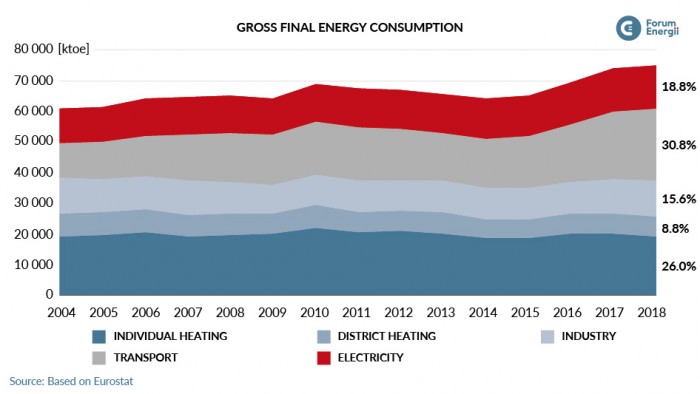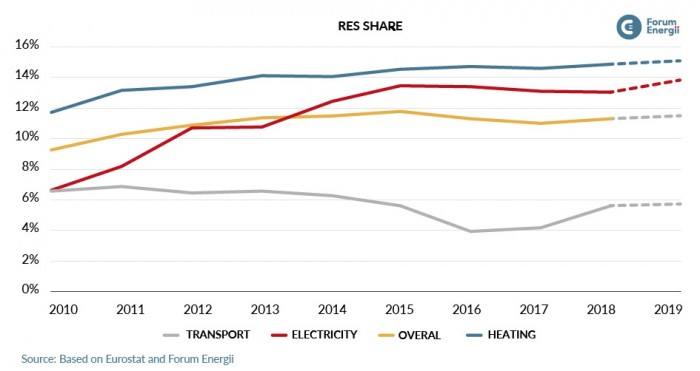Final data from Eurostat, the EU statistical office, on the achievement of the 2020 target will be available in January 2022. Slightly sooner, at the end of 2021, the estimates will be presented by the Polish statistical office. Such a long time of statistical information processing means that we do not know yet our share of RES for 2019. That is why Forum Energii has made an attempt to estimate this indicator already today. The "RES target calculator" developed by analysts of Forum Energii shows not only the share of renewable energy sources in the mix for the previous year. Also, it allows us to indicate which planned actions may have the greatest impact on the implementation of the RES target[2], although of course it should not be the only aspect for evaluating a given policy.
How is the RES share calculated?
The RES share is a simplified relationship of:
- consumed energy from renewable sources (numerator)
- total energy consumption in the country (denominator).
This indicator combines energy production and energy demand. In achieving an adequate share of RES, it is important not only to increase the production of energy from renewable sources, but also to reduce the total energy demand, which is achieved, among others, by energy efficiency measures.
In order to track progress in achieving the RES target, the energy sector has been divided into three sub-sectors: electricity, transport, and heating. The latter includes industry, district heating and individual heating (Figure 1).

How was it so far?
In 2018, the RES share in Poland amounted to 11.29%, which is approximately the same as in 2013. One of the reasons for such a slow growth of renewable energy sources in statistics is a large increase in energy consumption in Poland. This is particularly evident in the area of transport, where the official consumption of fuels has increased significantly - this is the effect of limiting the functioning of the so-called grey market in the fuel market.
Heating and transport play a dominant role in energy consumption. Therefore, an increased share of RES in these very sub-sectors has the greatest impact on the achievement of the RES target. When analysing the situation of each of them in detail, the following conclusions can be drawn:
- Heating - accounts for half of gross final energy consumption in the country (about 37.7 thousand ktoe in 2018), of which 52% is individual heating, 17% is district heating and 31% is industry. The use of RES in Poland is the highest in this sub-sector (14.8%). However, due to the lack of a coordinated policy, not much has changed in this sector in recent years: nearly 90% of heat from RES is obtained from solid biomass. Heat pumps provide only 1%, but the dynamic development of this market can undoubtedly be a positive signal.
- Transport - RES share in transport reached 5.63% in 2018. It is mostly due to the use of bioethanol and Fatty Acid Methyl Esters, which are added in appropriate proportions to petrol and diesel. The Eurostat statistics show that Poland experienced a very large decrease in the share of RES in transport between 2015 and 2016, from 5.62% to 3.92%, which is largely due to the aforementioned sudden increase in official fuel consumption. Since then, we have been recording an increase in this share each year. However, it has its limits. According to the EU legislation, the use of existing biofuels (the so-called 1st generation) may not exceed 7%.
- Electricity - electricity consumption in Poland equals approximately 19% of total gross final energy consumption. In this sub-sector, the RES share in 2018 amounted to 13.03%, which reflects a continuation of the downward trend observed for several years - in 2015 this share was 13.43%. The drops were caused by the increase of energy demand with simultaneous small changes in RES production. Nevertheless, this is the fastest changing sub-sector - in 2005-2015 the share of RES increased from 2.68% to 13.43%. This was largely a result of the wind energy development, but also of biomass, biogas and, as of 2015, a noticeable acceleration in PV.
What was the RES share in 2019?
Analysing the available data from individual sectors, Forum Energii prognoses indicate that the RES share in 2019 amounted to approx. 11.5%, i.e. 0.2 percentage point more than the year before[3]. Detailed estimates for the three sub-sectors, compared to 2018, are presented below:
- Electricity - 13.79%. Increase from 13.03%, which is a result of a decrease in electricity consumption with a parallel decrease in total production and an increase in net energy imports - by as much as 86%. Moreover, the RES generation was 8% higher than in 2018.
- Heating - 15.05%. Increase from 14.79%, as a result of a 6.7% decrease in consumption of all fuels, which is correlated with the number of heating days[4]. However, it remains difficult to estimate changes in the area of individual customers due to the lack of consumption data.
- Transport - 5.72%. Increase from 5.63%, due to a slightly faster growth rate of biofuels consumption compared to the use of liquid fossil fuels - one can observe it in the Energy Regulatory Office data.

What to expect in 2020?
The estimation of the 2020 RES share will be heavily influenced by the consequences of the economic slowdown caused by the coronavirus pandemic. At the same time, however, we observe a real boom in the Polish PV market. At the end of this June, the installed capacity amounted to ca. 2.1 GW, and the growth rate is expected to continue. It is possible to reach even 3 GW in the next six months. In addition, the production of electricity from biomass, wind and biogas is expected to increase.
These trends are certainly favorable for achieving the RES target, but they are still not sufficient to achieve 15% RES in 2020. Assuming a reduced demand for electricity by 4%, a decrease in the consumption of transport fuels by 8.6%, as well as a decrease in the use of fossil fuels in industry by 10%[5], the share of RES in 2020 may reach 12.2%. The missing total volume of energy from RES in all the sub-sectors is about 2,000 ktoe of gross final energy (23.1 TWh or 83.1 PJ). Such a large gap could be filled by e.g:
- Annual production of 9,8 GW of onshore wind farms, or
- Annual production of 5,9 GW offshore wind farms, or
- Annual production of 22 GW photovoltaic, or
- Replacement of 21% (approx. 1.1 million) of domestic coal boilers with renewable sources (collectors, biomass boilers)
Conclusions
- The forecasts of Forum Energii indicate that the share of RES in gross final energy consumption in 2019 increased by 0.2 percentage point to 11.5%. The growth in 2020 may be the highest since 2011. i.e. by 0.7 percentage point. With the economic slowdown indicators we have assumed, the RES share may reach 12.2%, still much less than the 15% target.
- Heating is the subsector with the highest energy consumption. An increase in the RES share in heat would have the greatest impact on increasing the share of renewable energy sources in the national energy mix. Meanwhile, heating, and households in particular, are still not covered by a comprehensive strategy for RES growth. This should change as soon as possible as the Directive RED II provides for national targets for the “greening” of heating by 2030.
- The electricity sub-sector consumes the least energy in the economy. Therefore, although the increase in the use of renewable sources in this area is very noticeable, in reality it translates to the smallest extent into progress in achieving the RES target. As a result, despite the construction of about 6.5 GW of new RES capacities in 2011-2019, the share of RES in the national mix changed only by 2.5 percentage points (from 9.25% in 2010 to 11.79% in 2019). However, it should be stressed that due to the development and huge reduction of the costs of wind and solar energy, the increase in RES in the power sector may be faster and at a lower cost than in other sub-sectors.
- It is possible to increase the use of biofuels in transport by the end of 2020, but probably by no more than 1 percentage point. Due to the EU regulations, the share of first-generation biofuels, i.e. those used in Poland, cannot be higher than 7%.
- Energy efficiency measures play a very important role. The lower energy consumption in the country, the less energy from RES has to be produced to achieve the RES target.
The development of the renewable energy sources sector should not, however, be considered only in the context of achieving the RES target. It plays a key role in transforming our energy sector. As a zero-emission source it is an effective tool in the fight against climate change and reduction of CO2 emissions.
[1] The European Union is committed to achieving a 20% share of energy from renewable sources in gross final energy consumption in 2020. According to the 2009 RED Directive, all member states have individually set targets to ensure that the EU plan is met. Poland has committed itself to achieve 15%. In 2009, the share of RES in Poland was 8.66%.
[2] The tool is based on the methodology implemented in the SHARES calculation sheet https://ec.europa.eu/eurostat/web/energy/data/shares. This sheet has been developed by Eurostat and is applicable to all Member States of the European Union.
[3] The proposed analytical approach was tested for the results for 2017 and 2018 and our indicators differed by a maximum of 0.1 and 0.2 percentage points from year to year.
[4] In this assumption, we did not take into account the biomass burned in district heating plants, because it is a renewable source.
[5] During the peak of the pandemic (March-April) we used on average 8% less electricity than a year before. This will certainly affect our total energy consumption in 2020, although the scale of the reduction in energy demand throughout the year will probably be less than during the pandemic. In the case of liquid fuel consumption, data for the second quarter is not yet available. Compared to 2019, a decrease in demand can be estimated at 8.6% (International Energy Agency, https://www.iea.org/reports/oil-market-report-june-2020). The annual decline in industrial production is projected at 10% (Polish Economic Institute).


